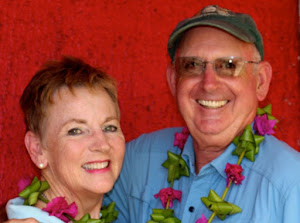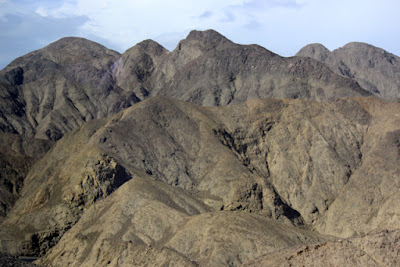Monday, March 21, 2016 WTRD 73
I don't often use the word amazing because when used too often, it becomes glib. Perhaps, I have traveled enough that I have developed an internal rubric for experiences and try to express with other adjectives ways to describe what I see so that I don't overuse a word that truly means to amaze. But today I was amazed!
Per our itinerary, early in the morning we were aboard a a large speed boat with 40 passengers heading out to the Ballastra Islands off the coast of the Peruvian desert. The sea and the wind are calm early in the morning.
We marveled at the sandy coast line and indigenous art still etched in the stone just under the sand. The exact age of how long the sculpture has been here is unknown, however it was first observed and recorded by European ships in the early 1800's.
As the desert heats with the rising sun, the hot air lifts and the cold air generated over the cold antarctic Humboldt current in the sea drops and fills the vacuum of the rising desert air, creating strong winds that keep the desert cool and dry during the day.
Opposite of what is usually expected in a desert (hot in the day, cool at night) when the sun goes down, this desert temperature rises as the surface temperature of sea and land equalize. The daytime wind ceases, and the warmth that is blown away during the day, sleeps calmly during the night.
We need to leave early, while the water and wind are calm and return by 10:00 am to port or the water becomes too rough. I expect to see birds, sea lions and maybe penguins once we get to the islands, but what was amazing was the volume of birds and sea lions.
The volume of the Humboldt penguins was small,
but the volume of other creatures was overwhelming: 10's or 100's of thousands of birds, nesting, and flying overhead like war time planes on a bombing mission.
 |
| Never ending migration of birds |
In fact, some of us did get bombed; hundreds and hundreds of seals and hundreds of babies
 |
| Only one of numerous colonies |
and lucky us about a dozen Humboldt penguins.
 |
| Mamas teaching babies to swim. |
Our guide told us there were at least 10 species of birds: pelicans, vultures (2 kinds), boobies, cormorants (2 kinds), and terns 2+ kinds.
 |
| Boobies on the Rocks |
When we visited Rapa Nui, we learned that the Peruvians enslaved the Rapa Nui for about 20 years to scrape and mine the guano that had accumulated over thousands of years on these islands. The guano was filled with nitrates which the Peruvians sold for gun powder and fertilizer. Mining guano was the primary revenue source of Peru until the late 1800's when the guano supply finally dwindled. Rapa Nui's population had been severely diminished by slavery, starvation on their own island, and disease from Europeans. The remains of the guano mining still remain.
Today, almost two hundred years of "newly" deposited guano is an assault to the nose as we pass down wind of the island. i cannot imagine how awful it would have been to be a slave mining this sh@! Several people on the boat became nauseous from the smell and the increased wave action as the sun rose higher in the sky.
 |
| The rocky islands were awash with increasing wave action |
Both leaving and coming back to port, we passed the opposite shore of the bay where a gigantic etching in the sand dune still remains from the indigenous people. Our guide told us the first recorded mention of this etching was in a ship's log in the 1800's. There were no indigenous people left who could explain the meaning or assign a time frame for when it was etched into the harder rock base beneath a veneer of sand. With less than 20 millimeters of rain a year (less than half a pinkie finger nail), there has been little erosion. The contrast of blue sky, blue water and desert sands tinted red and black from iron ore has a unique and stark beauty.
Once we were aboard our bus, we continue heading south. Our first stop is at winery where we learn about the process of fermenting the grapes that produce Pisco, both the Chilean and Peruvian drink. Of course, tasting the Pisco is the best part of the tour. The Pisco we taste is anywhere from 12-41% alcohol. A few of our group by a big bottle to share, and we buy a small bottle of cream Pisco with fig, a very nice after dinner drink.
Our second stop is at a desert Oasis. Surrounded by sand dunes, there springs a sweet water lagoon. It is a tourist attraction, and in every sense of the word, it is an oasis in the desert.
We stop long enough to buy lunch on the fly to eat while walking around or taking away to the bus to eat on our way to Nazca area where huge mysterious drawings, similar to the one we saw earlier today, rest in the desert flats. Russ and I plan to take a plane ride over the area to get a better look at the drawings.
Late afternoon;
After a long, twisted ride along the coast then across mountains eastward, we arrive in Nasca late in the day. It is windy and hazy from the blowing dust. The sun might be at a good angle for shadow contrast on the drawings, but they will be difficult to photograph in these conditions. We board a small six person plane, the men up front the women in the back (for weight balance), and I get stuck in the back seat with a small, crackled smudgy window from which to look out. Long story short, this was one of the most disappointing air flights we've taken. The setting sun created a a crackled glare, the window so small I could barely see.
What we should have seen, were line drawings of birds and animals hundreds of yards long. Many of them so big that we could only get a glimpse of a partial figure. I think had our altitude in the plane been higher, the entire figures would have been easier to see, but the haze and glare from the sun would have obscured them anyway. I have yet to edit the photos, so I really don't know what I snapped. One of our group is taking a private flight in the morning, she has promised to share some of her photos. If I post any here, they will most likely not be ours.

These drawings are a bit a of a mystery as they are etched on flat land and the only way to properly see them is from a bird's eye view, leading some to speculate that alien beings created them to see from their space craft. There is even one drawing, that I think Russ actually did get a photo of, called the astronaut.
My personal theory, is that since birds and fish are abundant and migrate over the barren land, the indigenous people living along the sparse water lines in the desert may have thought they were magical creatures that lived in the air and attributed some religious beliefs to these birds as god like and with powers of fllght, abundance, and the ability to "watch over" and possibly protect them. In response to these beliefs, they may have been trying to communicate with or appease or glorify these creatures. Anyway, I think it is a more likely scenario than alien spacecraft.
 |
| Spaceman - Astronaut |
 |
| Hummingbi |

After our air flight we took a small van out to our hotel. We turned off the main road in the middle of nowhere on to dirt road that looked like it also was going nowhere. Were we being abducted? The road was dusty, littered with trash. Shanty shacks and shabby buiidings dotted the road.
The gate opens, the van pulls in and we find ourselves in vast hacienda-like complex with lawns, swimming pool, peacocks, orchards, outdoor living areas, indoor living areas, covered walkways. It is the nicest hotel we've been in for a while. It would be a great place for wedding or reunion venue. Wow! A gem in the desert. Unfortunately, we arrive at 6:00 and are leaving at 6:30 for necessity shopping (snacks, atm, etc.) for our 10 hour bus ride to Arequipa.

Then we go to dinner. By now it is dark. There is a full moon. Once again we are on a dirt t road going somewhere, but where is only known by the guide. Initially, the bus driver passed the road and had to back up to find it. How do these tour companies find so many off-the-beaten track attractions. Of course, this is one of the reasons we keep booking with Peregrin and Intrepid tours. We like the path less taken.
We come to a another well maintained establishment where the local family has prepared a special meal called a pacha manca (Mother earth pot), It is a hybrid traditional Andes celebration of food, cooked in a pit with embers and hot rocks, then covered with desert dirt. Peter and Dainne in our group are selected to be the "god parents". They scatter Coca leaves over the dusty pit (locals read the scattered leaves like tea leaves).
Our guide tells us the signs are propitious. Then the couple pours wine over the pit in thanks and with a shovel takes the first two ceremonial shovels full of dirt off the mound.
The family uncovers the mound. Leaves and vegetable matter separate the layers of vegetables and meats that have been slow cooked all day. We feast on melted corn husk covered cheese, beef ribs, chicken, corn, sweet potatoes, and broad beans. There are marinated onions, and both mild and hot sauces to use on the food. We drink beer and enjoy the meal and our surroundings, returning to our hotel around 10:00. We are exhausted. It has been a busy day. The internet is not working, so this post will go out tomorrow.
We shower, wash some clothes, and go to bed despite our desire to try out the swimming pool. We are out of here at 8:00. Too bad, I could stay here a couple of days as long as I didn't need to leave the property.
All is Well With the Worrall Travel R's in Nasca, Peru.























































































